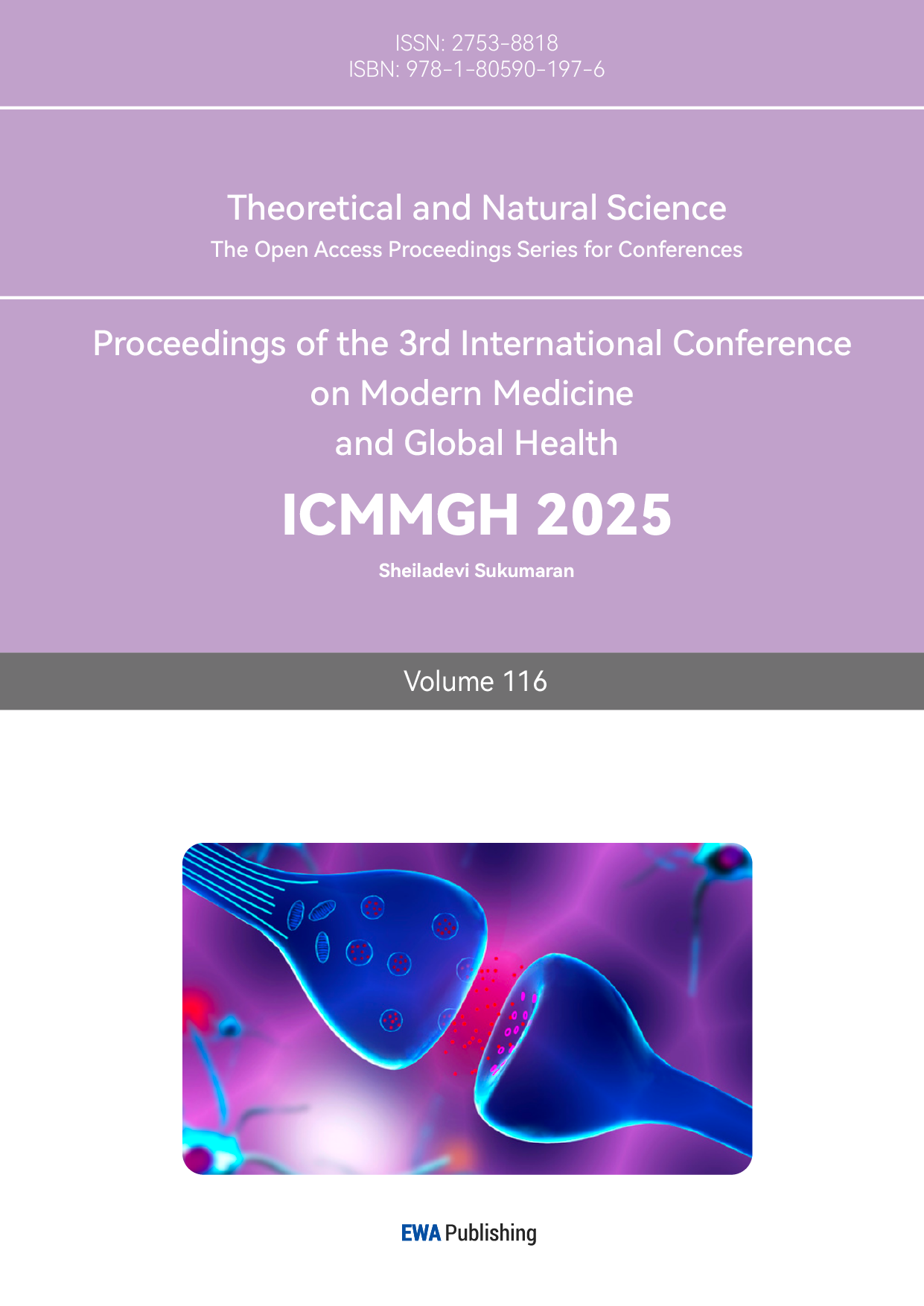1. Introduction
1.1. Neuroaesthetics
Neuroaesthetics, an emerging interdisciplinary field, has recently attracted widespread attention. By integrating neuroscience, psychology, aesthetics, and other disciplines, it aims to uncover the neural mechanisms behind human aesthetic experiences. One major area of research in neuroaesthetics is the role of music in emotion. Music’s emotional impact stems from elements like melody, rhythm, and harmony. Happy, upbeat tunes often evoke positive feelings, while sad or aggressive songs tend to trigger negative emotions. These emotional responses are directly linked to brain activity, making them a central focus of neuroaesthetic studies.
1.2. Neuroimaging techniques
Advances in neuroimaging techniques, such as fMRI and EEG, now allow researchers to observe brain activity in response to music more directly. These tools have provided valuable insights into the neural connection between music and emotion. Studies have shown that music activates several key brain areas, including the amygdala and prefrontal cortex, which are involved in processing emotions.[1] This activation leads to corresponding emotional responses in listeners.
1.2.1. Music and emotions
Understanding how emotions are triggered by music can be enhanced by a neuroaesthetic approach, which focuses on the neural basis of emotional reactions. Music can elicit strong emotional reactions—joy, sadness, calmness, or excitement—that are reflected in specific brain regions. This insight into the brain’s response to music offers a deeper understanding of how musical stimuli shape our emotional experiences. From neuroaesthetic perspective music is not a tangibility of melody rhythm harmony but stimulation that can be used to activate some region of brain and sack full of emotion. However, thanks to advanced neuroimaging techniques like functional magnetic resonance imaging (fMRI) and electroencephalography (EEG), scientists have been able to determine the "footprints" that music leaves in the brain — footprints which highlight just how interconnected music and emotion really are.
More specifically, studies in neuroaesthetics suggest that music activates brain areas related to the amygdala, which regulates our emotions; and ventral striatum, associated with reward mechanisms as well as hippocampus—key for memory formation. Activation of these regions allows us to appreciate the rhythm and emotional hue of music as well as to identify with the music, invoking memories and feelings associated with specific sections of the music.
The effect of music on individuals with mood disorders, such as depression, remains poorly understood. This study aims to fill that gap by exploring how the brain responds to positive and negative music, as well as non-music sounds, in both depressed patients and healthy controls. Using fMRI, we compare brain activity between the two groups while processing emotional auditory stimuli. This research hopes to expand our understanding of how music can be used therapeutically and its role in regulating mood.
2. Methods
2.1. Participants
The study had been conducted based on the dataset from OpenNeuro/ds000171 [2], which included functional MRI for 30 subjects-15 healthy controls and 15 with a diagnosis of depression. All participants gave informed consent, and local ethical review boards approved the study.
2.2. Experimental design
Participants listened to four types of auditory stimuli: positive music, negative music, positive non-music, and negative non-music. The stimuli were presented in randomized blocks, with each condition lasting approximately 30 seconds, followed by a rest period. Participants were instructed to passively listen to the audio while their brain activity was recorded.
2.3. Imaging and data analysis
fMRI data were acquired using a 3T MRI scanner. Preprocessing steps included motion correction, normalization, and smoothing. The analysis was conducted using Statistical Parametric Mapping (SPM), focusing on whole-brain contrasts to compare neural activation patterns between conditions (music vs. non-music, positive vs. negative) and groups (depressed vs. control).
3. Results
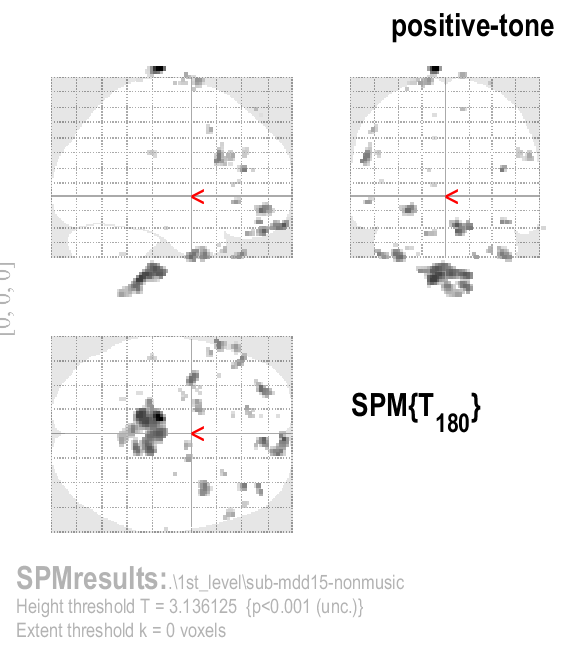
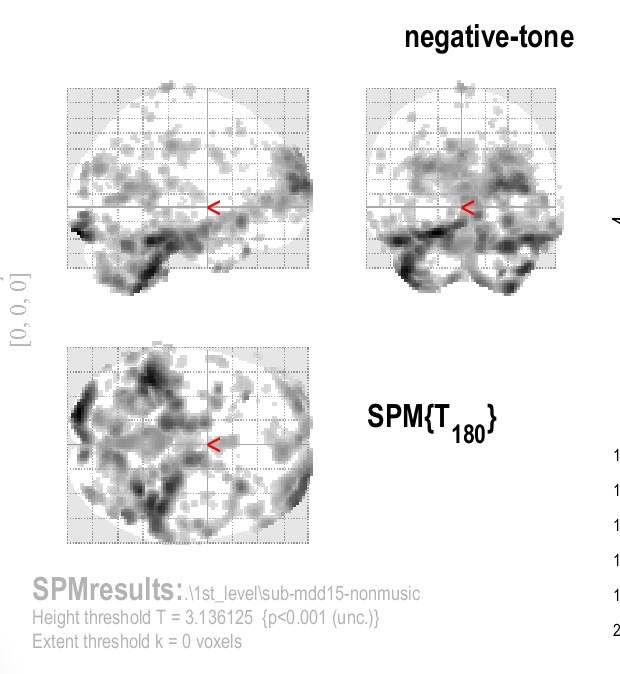
a b
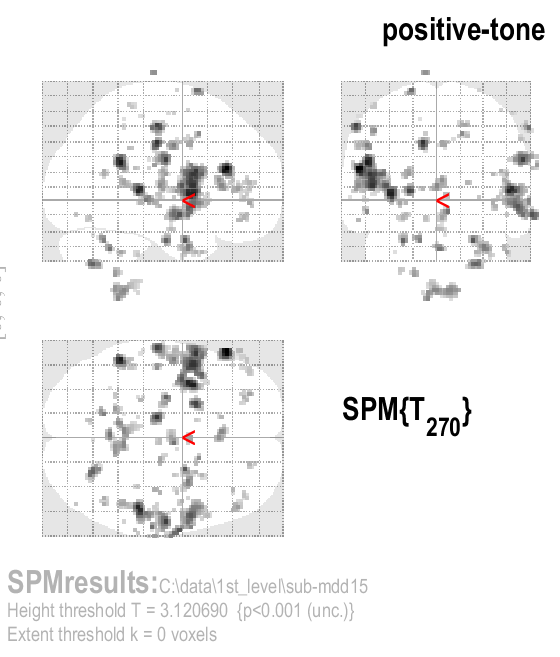
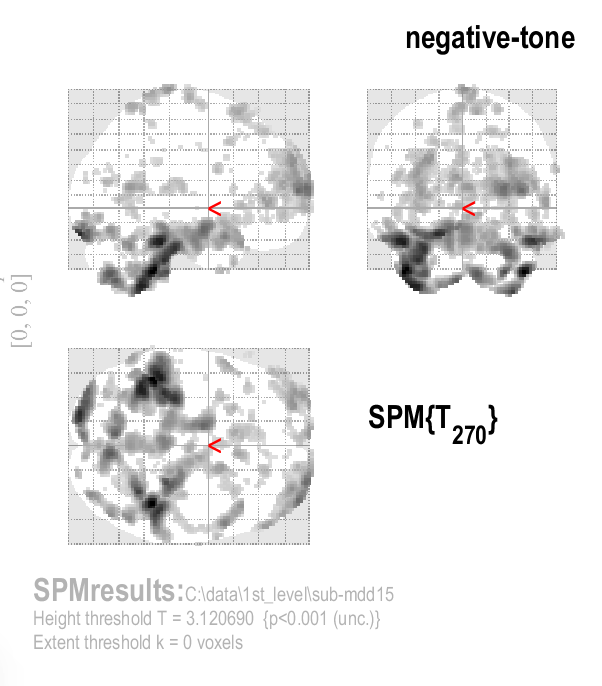
c d
Figure 1: fMRI imaging results1; a)Mdd-music-positive; b)Mdd-music-negative; c)Mdd-nonmusic-positive; d)Mdd-nonmusic-negative
Combined with MATLAB tools and neuroaesthetic studies, we performed the following analysis of the imaging result of SPM:
3.1. MDD-music
In depressed participants, there is increased activation in the amygdala and insula during music listening, especially for negative music. This suggests heightened emotional processing and sensitivity to negative emotional stimuli, consistent with mood disorder characteristics.
Reduced activation was observed in the prefrontal cortex, which could indicate decreased cognitive regulation or control over emotional responses.
3.2. MDD-nonmusic
For non-music stimuli, depressed individuals showed lower overall brain activation compared to music stimuli. The limbic system, particularly the hippocampus, still displayed some activity, potentially indicating residual emotional processing even in non-musical contexts.
There was also reduced activation in reward-related regions such as the nucleus accumbens, suggesting a diminished reward response to non-emotional auditory stimuli.
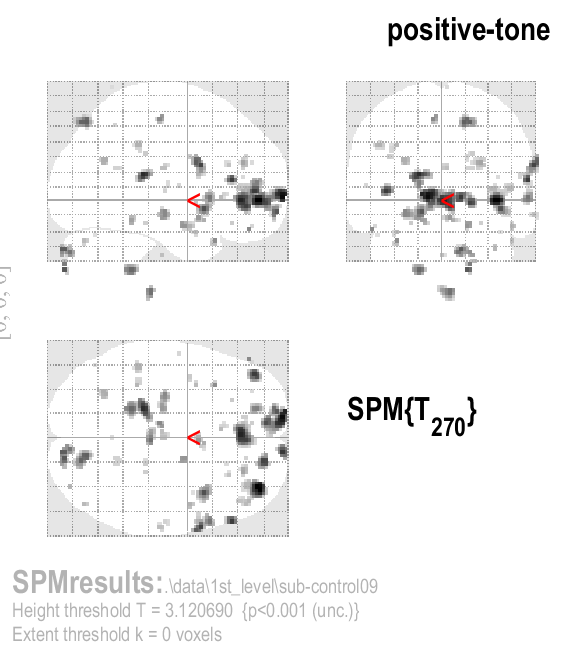
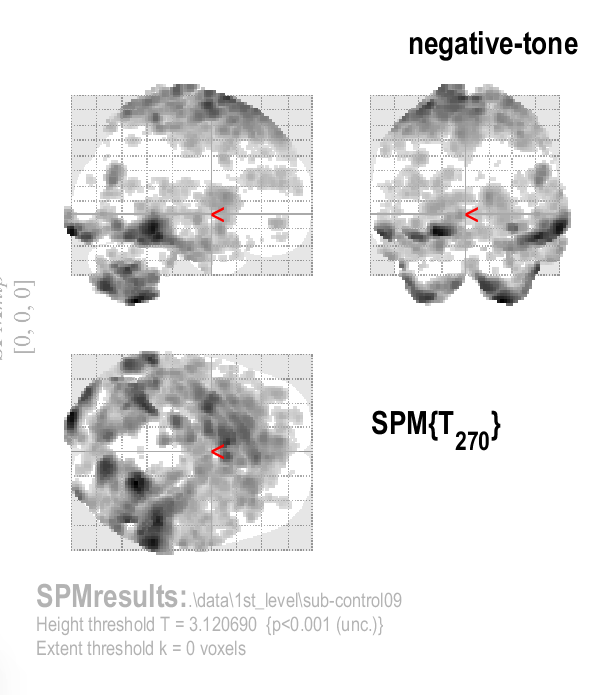
a b
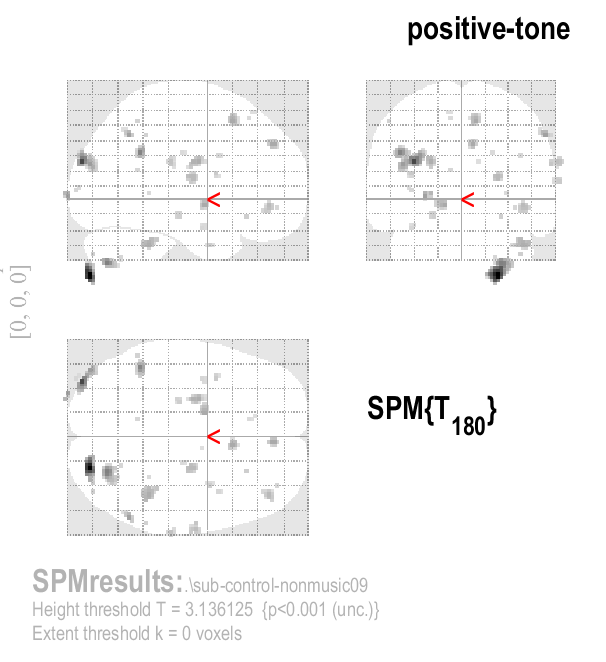
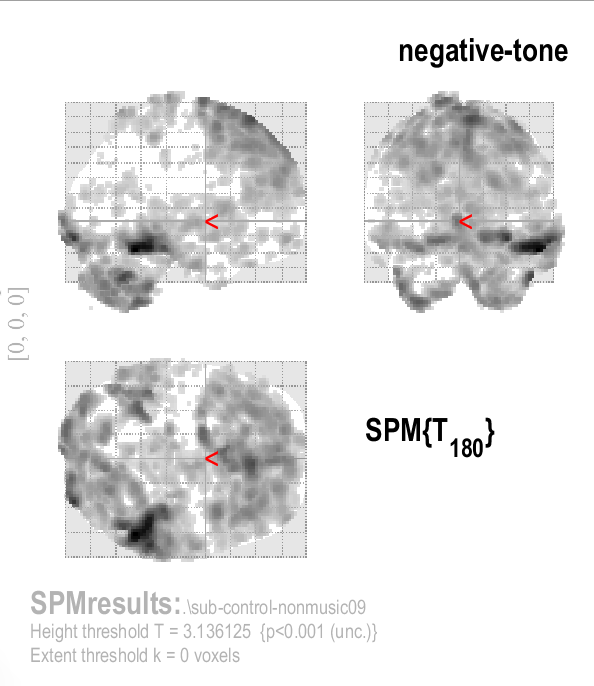
c d
Figure 2: fMRI imaging results2; a) Control-nonmusic-positive; b) Control-nonmusic-negative; c) Control-music-positive; d) Control-music-negative
3.2.1. Control-music
Healthy controls demonstrated higher activation in the prefrontal cortex and nucleus accumbent, especially during positive music, consistent with engagement of reward circuits. This indicates a robust positive emotional and reward-related response to music.
Activation in the auditory cortex was also stronger compared to the MDD group, suggesting more effective processing of musical stimuli.
3.2.2. Control-nonmusic
While non-music stimuli elicited lower activation compared to music, controls still showed moderate activity in auditory and prefrontal regions, reflecting some level of cognitive engagement even with non-musical sounds.
The amygdala activity was notably lower than in the MDD group, indicating a more regulated emotional response.
4. Discussion
4.1. Limbic system
We have to talk about the limbic system of the brain when we discuss the connection between emotions and the brain. The limbic system is responsible for the immediate reaction to emotions, and areas like the amygdala and hippocampus are involved in that process. For instance, as humans encounter a threat, the amygdala gets activated almost instantly; evoking fear and preparing the body to escape or fight. Such rapid mechanism of emotional response is critical to prompting human life.
4.2. Cerebral cortex
In addition to the limbic system, the cerebral cortex also contributes to defining and regulating emotions. The cortex is where higher cognitive functions occur — the area of processing, interpretation and regulation of emotions. The cerebral cortex, specifically the prefrontal cortex plays an important role in emotion regulation. Studies have demonstrated that the amount of activity in prefrontal cortex impacts how strongly and long an individual reacts to emotional stimulation. Neurotransmitters are also an important part of the process for creating emotions. For instance, neurotransmitter levels such as dopamine and serotonin also affect emotional state. Dopamine secretion is typically related to pleasure and reward, while low serotonin may cause depression.
4.3. Neuroimaging
Neuroimaging advances provided a way to visualize how music interacts with the brain directly. For example, using methods like functional magnetic resonance imaging (fMRI) researchers have discovered that multiple regions of the brain collaborate to create a multi-faceted neural circuit when listening to music. This network involves the amygdala (emotional processing), the ventral striatum (reward circuitry), and the hippocampus (memory and cognition). The regions that lit up have to do with what kind of music being heard and how they respondents react emotionally.
This study explores the modulation of neural processing in depressed patients and healthy controls by positive vs. negative music vs. non-music auditory stimuli. The findings also show that different groups exhibited dissimilar levels of brain activity, suggesting a change possibly in the way emotions are processed due to depression.
The increased activation in the amygdala and insula exhibited by the depressed group as compared to controls while listening to negative music aligns with emotion-processing biases typically associated with depression [3], whereby people who are depressed often show greater emotional responding when exposed to negative stimuli. This is in accordance with findings in neuroaesthetics, that show the relevance of the amygdala for such emotional processing when exposed to emotionally charged stimuli as music [4]. The increased insula activity supports this further with its role in integrating emotional and sensory or visceral experiences, suggesting an amplified internal emotional response to negative stimuli [5].
These participants exhibited increased activation of the prefrontal cortex and nucleus accumbent during listening to positive music than their counterparts, suggesting enhanced use of cognitive regulation and reward circuits [6]. The nucleus accumbent has been implicated in rewards and pleasure processing [7], while a critical brain region for cognitive control of feelings is the prefrontal cortex. This evidence corroborates the principles of neuroaesthetics, which highlights that since the brain has the potential to regulate emotions using top-down mechanisms; it can harness positive and aesthetically appealing stimuli [8].
Such lower brain activation in non-music conditions compared to both music and control group supports using musical elements for emotional circuit focused activation since these stimuli don't elicit similar responses like those produced by a musical stimulus irrespective of the subjects being tested. This highlights the singular role music plays in stimulating neural pathways linked to emotion, memory, and reward, thus bolstering the hypothesis that it has notable implications for mood regulation as evidenced by earlier findings noted in neuroaesthetic literature [9].
Collectively, these findings support the idea that depression is marked by increased sensitivity to negative emotional stimuli and reduced activation in reward-related regions of brain [10]. These neural patterns could account for the reduced ability of those with depression to enjoy positive experiences, a fundamental aspect of the disorder. The study's results help illustrate how musical stimuli could lend themselves as a method of therapy targeting these neural differences and subsequently aid in the improvement of mood regulation in depression.
Further studies are needed to assess the diagnostic and therapeutic applications of music relying on interindividual variability of neural response, including types of genres. Furthermore, exploring the long-term impact of music interventions on neuroplasticity may provide insights to optimize treatment strategies for mood disorders.
4.4. Music
Music has a profound influence over emotional and psychological healing. “Music has repeatedly been shown to activate the emotional part of the brain and influence an individual’s mood,” explains Jacqueline Tio, a clinical musicologist in Singapore. This influence is not only reflected in the daily emotion management, but also has a wide range of application prospects in the psychological rehabilitation field. Music cannot be neglected in its function of regulating emotions and psychological rehabilitation. Through the provision of emotional resonance and non-verbal communication, as well as promoting neuroplasticity changes in the brain, music brings unique and effective therapeutic experience to patients undergoing psychological rehabilitation.
The spirit of music in psychology rehabilitation is also applied to activate the plasticity of brain nerves. Musical stimulation has been shown to activate a multitude of brain regions, including those involved with emotional processing and memory and cognitive working functions. They can undergo positive changes in their cerebral neural nets through a long-term music therapy that regulates the biochemistry of emotions. Such changes have deep ramifications for psychological rehabilitation patients, not only enabling them to better potentially manage their emotions, but also enhancing their quality of life in general.
5. Conclusion
As a form that transcends the limits of culture and language, music has long been a hot research topic of neuroaesthetics for its influences on human emotions. This unique utility of music in emotion regulation has been better understood by conducting a series of key findings through the intrinsic association between music and emotion [11].
Music can enhance effect of mood one providing into a drastic manner. According to experimental data, the emotional state of subjects changes significantly after music-stimulation, and this change shows a high degree of agreement with the emotional expression characteristics of music. Music plays a key role in emotion regulation. Studies have found that music can effectively relieve negative emotions such as anxiety and depression, and improve people's mental health. Especially in the field of psychotherapy, music has been widely used in the rehabilitation training of emotional disorders, and has achieved remarkable results. By choosing the appropriate type and playing method of music, it can help patients better control their emotions and promote their comprehensive physical and mental rehabilitation.
With the deepening of neuroaesthetic research, the mechanism of music's influence on emotion has attracted more and more attention from scholars. In the future, this field is expected to usher in broader development space and application prospects.
From the perspective of research direction, neuroaesthetics will further reveal the complex relationship between music and the brain. With the help of advanced neuroimaging techniques, such as functional magnetic resonance imaging (fMRI) and electroencephalography (EEG), researchers can more precisely locate the regions in the brain where musical stimuli are processed, thus gaining insight into how music elicits emotional responses. With the continuous progress of artificial intelligence and machine learning technology, it is possible to analyze large-scale music and emotion data, which will provide strong support for revealing the quantitative relationship between music characteristics and emotional feelings.
At the application level, music therapy based on neuroaesthetics will be more personalized and precise [12]. According to the emotional needs and music preferences of different individuals, therapists can design customized music therapy to more effectively regulate the emotional state of patients. For example, for patients with anxiety disorders, music with a soothing rhythm and harmonious melody can be selected to reduce their anxiety level; For people with depression, they may be more inclined to use music with positive emotional colors to boost their mood. This individualized treatment strategy is expected to significantly improve the clinical effect of music therapy.
Neuroaesthetics and music emotion research will have more abundant research results and a wide range of application scenarios in the future. With the continuous progress of related technology and the strengthening of interdisciplinary cooperation, this paper has reason to believe that this field will bring more profound artistic experience and emotional healing to human [13].
Acknowledgement
Jiaxuan Lin, Yubo Wang contributed equally to this work and should be considered co-first authors.
References
[1]. Koelsch, S. , & Siebel, W. A. (2005). Towards a neural basis of music perception. Trends in Cognitive Sciences, 9(12), 578-584. https://doi. org/10. 1016/j. tics. 2005. 10. 001
[2]. Rebecca J. Lepping and Ruth Ann Atchley and Evangelia Chrysikou and Laura E. Martin and Alicia A. Clair and Rick E. Ingram and W. Kyle Simmons and Cary R. Savage (2018). Neural Processing of Emotional Musical and Nonmusical Stimuli in Depression. OpenNeuro. [Dataset] doi: null
[3]. Neuroaesthetics. D Keller - 2013 - academic. oup. com https://academic. oup. com/bjaesthetics/article-abstract/53/1/125/14166
[4]. The arts are more than aesthetics: Neuroaesthetics as narrow aesthetics. S Brown, E Dissanayake - Neuroaesthetics, 2018 - taylorfrancis. com https://www. taylorfrancis. com/chapters/edit/10. 4324/9781315224091-4/arts-aesthetics-neuroaesthetics-narrow-aesthetics-st even-brown-ellen-dissanayake
[5]. Neuroaesthetics: The cognitive neuroscience of aesthetic experience. MT Pearce, DW Zaidel, O Vartanian… - Perspectives on …, 2016 - journals. sagepub. com https://journals. sagepub. com/doi/abs/10. 1177/1745691615621274
[6]. Neuroaesthetics. A Chatterjee, O Vartanian - Trends in cognitive sciences, 2014 - cell. com https://www. cell. com/article/S1364-6613 (14), 00075-8 / fulltext
[7]. Neuroaesthetics. M Skov, O Vartanian, C Martindale, A Berleant - 2009 - api. taylorfrancis. com https://api. taylorfrancis. com/content/books/mono/download?identifierName=doi&identifierValue=10. 4324/9781315224091&type= googlepdf
[8]. Shi Chunyan. Music neurofeedback training improves negative emotion and attention state of college students. Yanshan University, 2020-06-01 https://kns. cnki. net/kcms2/article/abstract?v=j6HAoO1nZAyGUF4wsKgz40yJBFAp4YuRYV9sZ9zSMIViMUdn7cCuSrLA_bYlxbjdF3Crs4k3Yf rTZu1JJg2uxiEx1fPB5U_C8qxg7yjcYVzAgb2fTAro_nvKE0RUeNUcqpIwNx8jDggWFPOKsQksLQ==&uniplatform=NZKPT&language=CHS
[9]. Liu Xiao-hui and Gao Rui-xiang. On the neural mechanism and experience form of music aesthetics. Guangdong sea breeze, 2023-04-15 https://kns. cnki. net/kcms2/article/abstract?v=j6HAoO1nZAzjAvSFSrFUo_Eh6fZyEIVT7f9-agc5DhJRVRGLzn1IeEUtoYwwPSHmFFpqXLbrB7 YqTtHG3Fu_YLVd9ulzXLX8VQwc_obikOBFEYSQ1XNY3D-v5bDSaunQzYZ76_M8Ef2w6DufBjaRnw==&uniplatform=NZKPT&language=CHS
[10]. Wendanhong. Music therapy orientation of group psychological counseling on female secondary vocational student's premenstrual mood intervention study. Guangxi Normal University, 2020-06-30 https://kns. cnki. net/kcms2/article/abstract?v=j6HAoO1nZAx0o2cCdDZDoUCxYwErs2Dv7Fjm5JvovR-DOPsBstbiOBFZ1ivLL1jTUP5UVVnFA5 UmLGDtVNdZCplHRCoPas0IedfqpGPDj7i5nsuGolirVbZkK7pEIuDACuIoU-J9IV7n68cWiMiM1A==&uniplatform=NZKPT&language=CHS
[11]. Juslin, P. N. , & Sloboda, J. A. (2001). Music and Emotion: Theory and Research. Oxford University Press. [Available on Oxford Scholarship Online]
[12]. Gutiérrez, E. , & Camarena, B. (2015). The effects of music therapy on anxiety and depression. Psychology, 6(16), 1930-1938. https://doi. org/10. 4236/psych. 2015. 616189
[13]. Koelsch, S. (2010). Towards a neural basis of music-evoked emotions. Trends in Cognitive Sciences, 14(3), 131-137. https://doi. org/10. 1016/j. tics. 2010. 01. 002
Cite this article
Lin,J.;Wang,Y. (2025). The Influence of Neuroaesthetic Music on Human Mood. Theoretical and Natural Science,116,113-121.
Data availability
The datasets used and/or analyzed during the current study will be available from the authors upon reasonable request.
Disclaimer/Publisher's Note
The statements, opinions and data contained in all publications are solely those of the individual author(s) and contributor(s) and not of EWA Publishing and/or the editor(s). EWA Publishing and/or the editor(s) disclaim responsibility for any injury to people or property resulting from any ideas, methods, instructions or products referred to in the content.
About volume
Volume title: Proceedings of the 3rd International Conference on Modern Medicine and Global Health
© 2024 by the author(s). Licensee EWA Publishing, Oxford, UK. This article is an open access article distributed under the terms and
conditions of the Creative Commons Attribution (CC BY) license. Authors who
publish this series agree to the following terms:
1. Authors retain copyright and grant the series right of first publication with the work simultaneously licensed under a Creative Commons
Attribution License that allows others to share the work with an acknowledgment of the work's authorship and initial publication in this
series.
2. Authors are able to enter into separate, additional contractual arrangements for the non-exclusive distribution of the series's published
version of the work (e.g., post it to an institutional repository or publish it in a book), with an acknowledgment of its initial
publication in this series.
3. Authors are permitted and encouraged to post their work online (e.g., in institutional repositories or on their website) prior to and
during the submission process, as it can lead to productive exchanges, as well as earlier and greater citation of published work (See
Open access policy for details).
References
[1]. Koelsch, S. , & Siebel, W. A. (2005). Towards a neural basis of music perception. Trends in Cognitive Sciences, 9(12), 578-584. https://doi. org/10. 1016/j. tics. 2005. 10. 001
[2]. Rebecca J. Lepping and Ruth Ann Atchley and Evangelia Chrysikou and Laura E. Martin and Alicia A. Clair and Rick E. Ingram and W. Kyle Simmons and Cary R. Savage (2018). Neural Processing of Emotional Musical and Nonmusical Stimuli in Depression. OpenNeuro. [Dataset] doi: null
[3]. Neuroaesthetics. D Keller - 2013 - academic. oup. com https://academic. oup. com/bjaesthetics/article-abstract/53/1/125/14166
[4]. The arts are more than aesthetics: Neuroaesthetics as narrow aesthetics. S Brown, E Dissanayake - Neuroaesthetics, 2018 - taylorfrancis. com https://www. taylorfrancis. com/chapters/edit/10. 4324/9781315224091-4/arts-aesthetics-neuroaesthetics-narrow-aesthetics-st even-brown-ellen-dissanayake
[5]. Neuroaesthetics: The cognitive neuroscience of aesthetic experience. MT Pearce, DW Zaidel, O Vartanian… - Perspectives on …, 2016 - journals. sagepub. com https://journals. sagepub. com/doi/abs/10. 1177/1745691615621274
[6]. Neuroaesthetics. A Chatterjee, O Vartanian - Trends in cognitive sciences, 2014 - cell. com https://www. cell. com/article/S1364-6613 (14), 00075-8 / fulltext
[7]. Neuroaesthetics. M Skov, O Vartanian, C Martindale, A Berleant - 2009 - api. taylorfrancis. com https://api. taylorfrancis. com/content/books/mono/download?identifierName=doi&identifierValue=10. 4324/9781315224091&type= googlepdf
[8]. Shi Chunyan. Music neurofeedback training improves negative emotion and attention state of college students. Yanshan University, 2020-06-01 https://kns. cnki. net/kcms2/article/abstract?v=j6HAoO1nZAyGUF4wsKgz40yJBFAp4YuRYV9sZ9zSMIViMUdn7cCuSrLA_bYlxbjdF3Crs4k3Yf rTZu1JJg2uxiEx1fPB5U_C8qxg7yjcYVzAgb2fTAro_nvKE0RUeNUcqpIwNx8jDggWFPOKsQksLQ==&uniplatform=NZKPT&language=CHS
[9]. Liu Xiao-hui and Gao Rui-xiang. On the neural mechanism and experience form of music aesthetics. Guangdong sea breeze, 2023-04-15 https://kns. cnki. net/kcms2/article/abstract?v=j6HAoO1nZAzjAvSFSrFUo_Eh6fZyEIVT7f9-agc5DhJRVRGLzn1IeEUtoYwwPSHmFFpqXLbrB7 YqTtHG3Fu_YLVd9ulzXLX8VQwc_obikOBFEYSQ1XNY3D-v5bDSaunQzYZ76_M8Ef2w6DufBjaRnw==&uniplatform=NZKPT&language=CHS
[10]. Wendanhong. Music therapy orientation of group psychological counseling on female secondary vocational student's premenstrual mood intervention study. Guangxi Normal University, 2020-06-30 https://kns. cnki. net/kcms2/article/abstract?v=j6HAoO1nZAx0o2cCdDZDoUCxYwErs2Dv7Fjm5JvovR-DOPsBstbiOBFZ1ivLL1jTUP5UVVnFA5 UmLGDtVNdZCplHRCoPas0IedfqpGPDj7i5nsuGolirVbZkK7pEIuDACuIoU-J9IV7n68cWiMiM1A==&uniplatform=NZKPT&language=CHS
[11]. Juslin, P. N. , & Sloboda, J. A. (2001). Music and Emotion: Theory and Research. Oxford University Press. [Available on Oxford Scholarship Online]
[12]. Gutiérrez, E. , & Camarena, B. (2015). The effects of music therapy on anxiety and depression. Psychology, 6(16), 1930-1938. https://doi. org/10. 4236/psych. 2015. 616189
[13]. Koelsch, S. (2010). Towards a neural basis of music-evoked emotions. Trends in Cognitive Sciences, 14(3), 131-137. https://doi. org/10. 1016/j. tics. 2010. 01. 002





